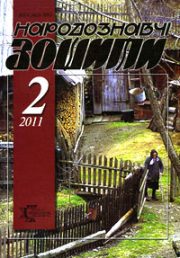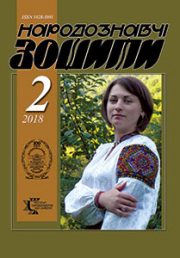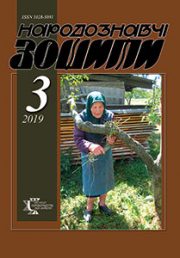The Ethnology Notebooks. 2019, № 3 (147), 660—669
UDK 394.262.5 (477.86)
DOI https://doi.org/10.15407/nz2019.03.660
SEREBRYAKOVA Olena
ORCID ID: https://orcid.org/0000-0002-1039-2920
Candidate of Historical Sciences,
research worker of the department of the modern ethnology
of the Ethnology Institute
of National Academy of Sciences of Ukraine
15, Svobody Avenue, 79000, Lviv, Ukraine
Contacts: e-mail: o-sereb@ukr.net
Abstract. Actuality of the article is due to the fact that there is still no special intelligence about the local peculiarities of the existence of mantic and magic actions in Pokuttia region. They were carried out the time of the twelve days between Christmas and Epiphany in order to predict the crop. Therefore in the offered article the aim is coverage of the layer the custom of ritual and world-view phenomena associated with the divination and magic actions about the harvest of wheat, potatoes, cabbage, onions, beets, carrots, fruit trees, honey, amount of bees, cows and calves etc. Among them — varieties, prophetic signs, mythological presentations, archaic elements etc.
The object of research is the traditional world view and the custom and rite culture of the inhabitants of Pokuttia, and the subject — the mantic and magic actions with different ritual attributes, which carried out to during various holidays of Christmas and Epiphany time. The basis for the article are the materials of the author’s field research during 2013—2014, 2016—2017 in the villages of Kolomyjs’kyj, Sniatyns’kyj, Tlumats’kyj, Tysmenyts’kyj and Gorodenkivs’kyj districts of Ivano-Frankivs’k oblast’, local lore articles and works of the end of nineteenth and the beginning of the twenty-first centuries. Also comparative material from other regions of Ukraine is presented. For the best opening of originality of divination and magic actions in Pokuttia region use also information about them in the traditional culture of other people of the world. The methodology of this work is based on general scientific methodological principles and the basic requirements that apply to the works of historical and ethnological direction.
Mantic and magic traditions related to the ceremonial use of ritual meals, straw crosses, axe, coals, seeds and vegetable crops of different varieties, salt, candle etc. in the fortunetelling and magic actions the time of the twelve days between Christmas and Epiphany of the inhabitants of Pokuttia are analyzed.
It was found out that the ethnolocal version of the mantic and magic actions with different attributes in the inhabitants of Pokuttia is included in the all-Ukrainian canvas, while preserving its peculiar features (local variants of catching wheat, the use of wheat that was collected from the ceiling, functional purpose of straw crosses, ritual «feeding» of fruit trees etc.). According to field records some divination and magic actions are now taking place or they are still stored in memory old local people in some villages of Pokuttia region. It gives an opportunity in future to study the investigated fenomena on this territory.
Keywords: mantic and magic actions/practices (divination), Pokuttia, holidays of Christmas and Epiphany time, crop.
Received 25.03.2019
REFERENCES
Kolberg, O. (1882). Penance. Ethnographic picture (Vol. I). Krakow [in Polish].
Mroczko, K. (1897, April). Sniatynszczyzna. (A contribution to national ethnography). Scientific and literary guide (Vol. XXV, pp. 289—304) [in Polish].
Mroczko, K. (1897, may). Sniatynszczyzna. (A contribution to national ethnography). Scientific and literary guide (Vol. XXV, pp. 385—402) [in Polish].
Waigel, L. (1877). Essay of the city of Kolomyia: Drukiem H. Zadembskiego i spolki [in Polish].
Archive of the IN NANU (Archive of the Institute of Ethnology of the National Academy of Sciences of Ukraine). F. 1. Op. 2. Od. save 704 [in Ukrainian].
Tymchuk, M. (1994). The Burned Earth. The History of the Village of Grushki. Tlumach [in Ukrainian].
Kohut, B.O., & Sas, O.L. (1998). Essays on the History of Pawelchas (Pavlovka). Ivano-Frankivs’k: Lik [in Ukrainian].
Zholobajlo, Ya. (2000). «This Matievka is our village…». Historical and ethnographic essay. Kolomyia: Vik [in Ukrainian].
Vozniak, M. (2003). My village — Ukraine’s blossom. Ivano-Frankivs’k: Nova Zoria [in Ukrainian].
Andrusiak, S., Bilyj, D., Dvoiak, M. & Kachorak, Ya (2007). Vikniyans: from the old to the present. L’viv: Ukr. Tekhnolohii [in Ukrainian].
Klodnyts’kyj, O. (1975). Folk life, customs and folklore of Tovmachiny. In Almanac of Stanislavivskoy of earth. Collection of materials is to history of Stanislavova and Stanislavschyny (Pp. 876—888).. N’iu-Jork; Toronto; Miunkhen [in Ukrainian].
Bazhans’kyj, M. (1982). The beauty of Sniatynskii: rivers, streams, forests, meadows, gardens, towns and villages and high material and spiritual culture of their inhabitants: Haslo v Encyclopedia. Ditrojt [in Ukrainian].
Velykochyj, V. (2014). Traditional New Year holidays of Pokutsk and their use in the modern tourist region of the region. Yamhoriv literary-regional and artistic almanac (P. 24—25, pp. 279—286). Yamhoriv [in Ukrainian].
Taras, Ya. (2017). Traditional horticulture and viticulture in Pokuttia. The Ethnology notebooks, 1 (133), 129—135 [in Ukrainian].
Kostiv, V. (Ed.). (2000). History of Ugrynova. Essays on the history of Ugryniv village in the Tysmenytsya district of Ivano-Frankivsk oblast. Ivano-Frankivs’k: Plaj, 2000 [in Ukrainian].
Isakov: historical and ethnographic essay (2004). Ivano-Frankivs’k: Nova Zoria [in Ukrainian].
Tokarev, S. (Ed.). (1973). Calendar customs and ceremonies in countries of foreign Europe. Winter holidays. Moskva: Nauka [in Russian].
Nikiforovskij, N.Ja. (1897). Simple signs and beliefs, superstitious rites and customs, legendary legends about people and places. Vitebsk [in Russian].
Franko, I. (1898). Human belief in Pidgiru. Ethnographic collection (Vol. V, pp. 160—218). Lviv.
Syrku, P. (1913). From the life of the Bessarabian Romanians. I. Folk calendar of the Romanian population in Bessarabia. Zhivaja Starina (Issue I—II, pp. 147—180). Kishinev [in Russian].
Jakovlev, G. (1905). Proverbs, sayings, krylatya words, signs and beliefs collected in the settlement of Saguny, Ostrogozhsk district. Zhivaja Starina (Issue I, II, pp. 141—180) [in Russian].
Borosh, M., Korachon’, Z. & Tatrayi, Zh. (2006). Christmas holidays (from adventist to baptism). Folk creation and ethnography (special issue 4, pp. 11—22) [in Ukrainian].
Popovich, Ju.V. (1974). Moldovan New Year holidays (XIX — early XX century). Kishinev: Shtiinca [in Russian].
Archive of the IN NANU. F. 1. Op. 2. Od. save 698 [in Ukrainian].
Petryshyn, V. (1985). More about the village of Gostov. In Almanac of Stanislavivskoy of earth. Collection of materials is to history of Stanislavova and Stanislavschyny (Vol. II, pp. 546—558). N’iu-Jork; Paryzh; Sidnej; Toronto [in Ukrainian].
Tolstoj, N.I. (1999). Slavic Antiquities: Ethnolinguistic Dictionary: in 5 vols. (Vol. 2: D—K) (Kroshki). Moskva: Mezhdunarodnye otnoshenija [in Russian].
Schnajder, J. (1912). Z zhycia gorali nadlomnickich. Lud (Vol. XVIII, pp. 141—217). Lwow [in Polish].
Kholmshchina and Pidlyashshya. Historical and ethnographic research. (1997). Kyiv: Rodovid [in Ukrainian].
Podillya: Historical and ethnographic research. (1994). Kyiv: Dolia [in Ukrainian].
Herasymovych, V. (1893, june). National customs, rituals and songs in the village of Krekhov, Balkov district. Pravda (Vol. XVII, issue LII, pp. 314—320). Lviv: Z drukarni NTSH [in Ukrainian].
Kozholianko, H. (2005). Christmas ritual of Hutsuls. Labours of NTSH. Study of a particular region (Vol. 1, pp. 111—119). Kosiv [in Ukrainian].
Syvyts’kyj, M. (1988). Spirit culture. In Lemkivschina: Earth — people — history — culture (Vol. I, pp. 102—194). N’iu-Jork; Paryzh; Sydnej; Toronto [in Ukrainian].
Kolesa, F. (1898). Human Beliefs on Pidgiru, in. Hodovichach Stryj district. In Ethnographic collection (Vol. V, pp. 76—98). Lviv [in Ukrainian].
Shukhevych, V.O. (1999). Hutsulshchyna. The fourth part. 2 edition (Fourth part, second edition).. Verkhovyna: Hutsul’schyna [in Ukrainian].
Ivanov, P. (1907). Life and beliefs of the peasants of the Kupyansk district. Har’kov: Pechatnoe Delo [in Russian].
Falkowski, J., & Pasznycki, B. (1935). On the border of Lemkowsko-bojkowskiem. Lwow: Nakladem tow-wa ludoznawczego [in Polish].
Sarna, K. (1908). Description of the Jasielski poviat. Jaslo [in Polish].






